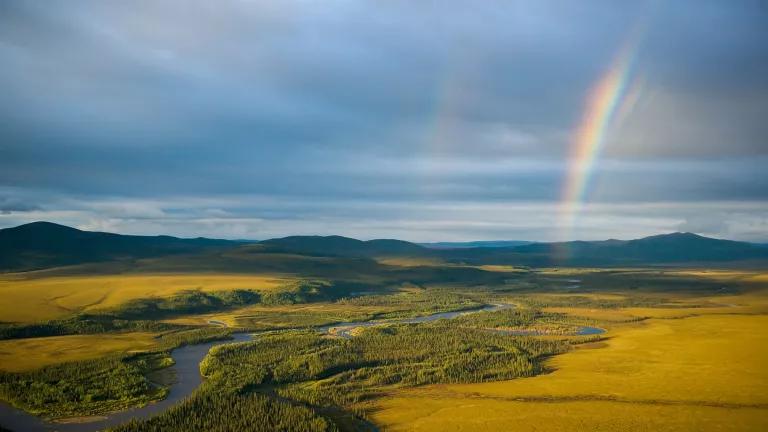Latin America 2017: Top Three Green Trends

This blog was co-authored by Andrés Anchondo. He is the Latin America Project’s intern working on Conservation Finance in Latin America.
For Latin America, 2017 will be remembered for the barrage of natural disasters exacerbated by climate change, including hurricanes, floods, and fires, which highlighted the urgent need for creating greater resiliency for the region’s communities and critical ecosystems. Amid these catastrophes were examples of Latin American countries that showed leadership in fighting climate change, protecting nature and paving the way toward a sustainable future.
The region’s efforts to mitigate and respond to climate change ranged from boosting renewable energy to protecting biodiverse species and ecosystems. This comes as no surprise, given that a recent poll by Latinobarómetro found that more than 70 percent of Latin Americans prioritize fighting climate change over economic growth. The new year is almost upon us, making this an apt moment to reflect on the past year’s green accomplishments and take stock of significant events related to the environment and natural resources.
Here are three climate and environmental trends in Latin America in 2017 that deserve mention:
1. Fueling a Greener Future with Renewables
2017 witnessed several landmark achievements for renewable energy in Latin American countries. Chile, for example, opened the first geothermal plant in South America. This facility will allow Chile to avoid 166,000 tons of carbon emissions while providing 165,000 homes with electricity. Brazil contributed to this trend by opening the two largest solar parks in Latin America. The parks’ almost 1.8 million solar panels will supply clean energy to 600,000 Brazilian households.
Renewables are allowing Latin American countries of all sizes to reduce their dependence on fossil fuels. For example, Guatemala, Honduras, and Uruguay, produce 71, 61, and 62 percent of energy, respectively, from renewable sources. Bloomberg New Energy Finance’s Climatescope ranked Brazil, Chile, Uruguay and Mexico among the ten best countries in 2017 to attract private investments in renewables.
2. Funding a Low-Carbon Transformation
Latin America has become a leader in attracting international investment for low-carbon infrastructure. The World Bank’s International Finance Corporation (IFC) projects the region’s infrastructure and transportation to reach US$1 billion by 2030. Clean energy auctions and supportive policy frameworks have helped make this possible. For example, renewable energy auctions in Chile and Mexico again set record low prices, and Argentina’s latest auction saw prices that were 30 percent lower than the previous round. Colombia also announced that next year it plans to hold its first auction for clean energy projects, such as solar and wind. Moreover, as it enters a new era of peace, Colombia is prioritizing the fight against climate change and deforestation, launching a sustainable fund of US$210 million.
There have also been important advances in developing green financial tools such as green bonds that may help national and local governments finance not only clean energy projects, but also sustainable transportation, water and development projects. Mexico has initiated the use of green bonds in the region and 2017 saw several new issuances, including Mexico City’s second green bond. Meanwhile, in Colombia, Davivienda issued the largest green bond by a private financial institution in Latin America and Bancoldex issued the country’ first green bond available to local investors. Two provinces in Argentina similarly issued green bonds this year.
3. Protecting the Planet’s Most Biodiverse Region
A high percentage of the planet’s biodiversity is located within Latin America and the Caribbean. In 2017, key Latin American countries placed a major emphasis on preserving underwater treasures. Mexico established Revillagigedo National Park, the largest marine park in North America, comprising almost 15 million ha (37 million acres). Moreover, Costa Rica and Ecuador signed the Coral Reef Life Declaration, geared toward preserving healthy coral reef ecosystems. Cities in Argentina and Chile also banned plastic bags, a significant proportion of which end up in the ocean.
In addition to protecting marine areas, there were important advances for the conservation of terrestrial landscapes and freshwater resources. In March of 2017, the Chilean government received a donation of more than 400,000 ha (around 1 million acres) of land in Patagonia. This generous gift will allow the Chilean government to create a network of national parks the size of Switzerland. In case this occasion wasn’t sweet enough, river protectors and local communities scored a hard-fought victory over the HidroAysén project which would have built five mega dams on two of Patagonia’s most spectacular rivers. While the project’s environmental permit was revoked in 2014, the owners decided to definitively liquidate the project and return the water rights on the rivers just this year.
Finally, Latin America’s smallest nation, El Salvador, became the first country in the world to ban mining of all types of gold and other metals in order to protect fresh water.

What to expect for Latin America in 2018?
Having weathered an unfortunate spell of disasters, Latin America boasted several environmental accomplishments in 2017: from South America’s first geothermal energy plant and sizeable solar parks to green bonds and protected areas on land and sea. All of these efforts will make it easier for countries to build a more sustainable future. With 2017 as a sturdy foundation, what will next year have in store for the environment and natural resources in the region? In January, members of NRDC’s Latin America team will share their outlook for 2018.


